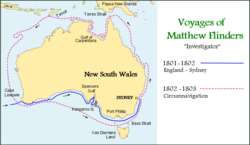Matthew Flinders
Matthew Flinders (16 March 1774 – 19 July 1814) was an English navigator and cartographer. He was the leader of the first circumnavigation of Australia and identified it as a continent.
Matthew Flinders | |
|---|---|
 | |
| Born | 16 March 1774 |
| Died | 19 July 1814 (aged 40) London, England |
| Occupation | Royal Navy Ships Officer |
| Spouse(s) | Ann Chappelle
(m. 1801) |
| Children | Anne |
Flinders made three voyages to the southern ocean between 1791 and 1810. In the second voyage, George Bass and Flinders confirmed that Van Diemen's Land (now Tasmania) was an island. In the third voyage, Flinders circumnavigated the mainland of what was to be called Australia, along with Aboriginal man Bungaree.
Heading back to England in 1803, Flinders' vessel needed urgent repairs at Isle de France (Mauritius). Although Britain and France were at war, Flinders thought the scientific nature of his work would ensure safe passage, but a suspicious governor kept him under arrest for more than six years. In captivity, he recorded details of his voyages for future publication, and put forward his rationale for naming the new continent 'Australia', as an umbrella term for New Holland and New South Wales – a suggestion taken up later by Governor Macquarie.
Flinders' health had suffered, however, and although he reached home in 1810, he did not live to see the publication of his widely praised book and atlas, A Voyage to Terra Australis.
Matthew Flinders Media
Chart of Van Diemen's Land (now called Tasmania) produced by Matthew Flinders
The voyages of Flinders aboard HMS Investigator
Discussion of Flinders and Nicolas Baudin's race to map Australia
St James's Gardens, tinted green and shown west of Euston railway station, on an 1890 Bacon Traveler's Pocket Map of London by George Washington Bacon
Church of St Mary and the Holy Rood, Donington, Lincolnshire, where Flinders was baptised, and was reburied in 2024
View of Port Jackson taken from the South by William Westall; engraving from Flinders' A Voyage to Terra Australis, published in 1814
1744 Chart of Hollandia Nova – Terra Australis by Emanuel Bowen
Statue of Flinders outside St Paul's Cathedral, Melbourne







